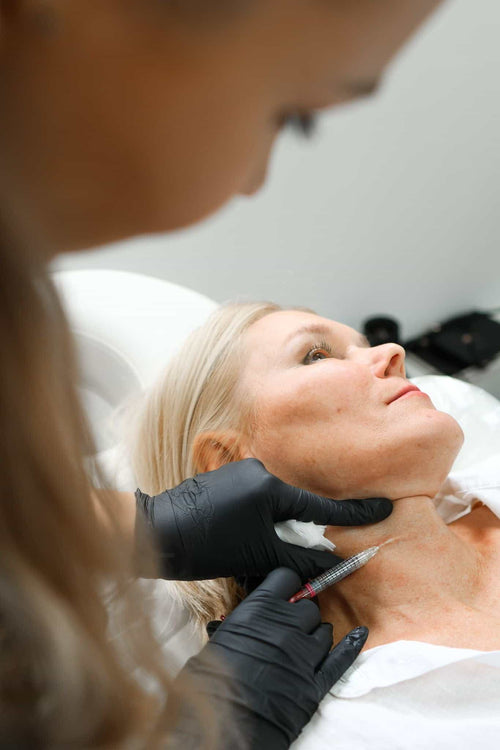Why Not To Get Jaw Filler?
Book Your Dermal Filler Appointment with Dr. Laura Geige at It’s Me and You Clinic

## Potential Complications
While dermal fillers have become increasingly popular for facial rejuvenation, it’s crucial to understand the potential complications associated with any medical procedure, including jaw augmentation.
One significant risk is asymmetry. The placement of filler can be challenging, and even slight variations can lead to an uneven appearance. This can be particularly noticeable in the jawline, which requires precise symmetry for a natural look.
Another concern is migration. Filler material can move from its intended location over time, resulting in lumps, bumps, or an unnatural contour.
Infection is always a risk with any injection procedure. While rare, it’s important to be aware of the possibility of infection and seek immediate medical attention if you experience any signs, such as redness, swelling, pain, or discharge.
Allergic reactions can also occur. Although fillers are typically formulated to minimize this risk, some individuals may be sensitive to certain ingredients. It’s crucial to discuss your medical history with the injector beforehand to identify potential allergens.
Vascular occlusion is a serious complication that can occur if filler is inadvertently injected into a blood vessel. This can restrict blood flow and potentially lead to tissue damage or even stroke.
Long-term effects of jaw fillers are not yet fully understood. Since filler is temporary, the need for repeated injections raises concerns about cumulative effects over time.
Additionally, there’s a risk of bruising, swelling, and tenderness at the injection site after the procedure. These side effects are usually temporary but can be uncomfortable.
Before making a decision about jaw filler, it’s essential to consult with an experienced and qualified injector. Discuss your goals, concerns, and medical history thoroughly to assess your suitability for the procedure and understand the potential risks and benefits.
### Infection Risk
Infections are a serious risk associated with any injection procedure, including jaw filler injections.
Here’s why:
-
Breach in Skin Barrier: During the injection process, the skin is punctured, creating an opening that allows bacteria to potentially enter the body. Even with sterile technique, there’s always a small risk of introducing microorganisms.
-
Foreign Material: The filler material itself can sometimes trigger an inflammatory response, making the area more susceptible to infection.
-
Oral Flora: The mouth harbors a large amount of bacteria. Jaw filler injections are performed near this bacterial reservoir, increasing the likelihood of contamination if proper sterile procedures are not strictly followed.
Signs of Infection
-
Redness and swelling around the injection site
-
Pain or tenderness that worsens
-
Warmth to the touch
-
Pus or drainage from the area
-
Fever
If you experience any of these symptoms after jaw filler injections, it’s crucial to seek medical attention promptly. Early treatment can help prevent serious complications.
### Nerve Damage

Nerve damage can occur during any medical procedure involving injections, and facial fillers are no exception.
In the case of jaw fillers, nerves responsible for controlling muscle movement and sensation in the face can be inadvertently damaged during injection.
This can result in a range of complications, including:
- Numbness or tingling: This may occur in areas around the injection site due to temporary compression or irritation of nerves.
- Loss of muscle function**: Damage to motor nerves can lead to weakness or paralysis of facial muscles, affecting chewing, smiling, or other expressions.
- Pain: Nerve injury can trigger chronic pain in the injected area or surrounding tissues.
- Asymmetry**: Uneven injection can lead to facial asymmetry and a distorted appearance.
While nerve damage from jaw fillers is relatively uncommon, it’s a serious potential complication that should not be ignored.
The risk of nerve damage can be minimized by choosing a qualified and experienced injector who uses proper techniques and sterile procedures.
It’s also important to discuss your medical history, including any pre-existing conditions or medications, with your injector before undergoing any facial filler treatment.
Be sure to ask questions about potential risks and complications, and don’t hesitate to seek a second opinion if you have concerns.
### Asymmetry or Uneven Results
Asymmetry, or uneven results, can be a significant concern when considering facial fillers, particularly for areas like the jawline. While injectables can enhance and define features, achieving perfectly symmetrical outcomes is challenging due to several factors.
Here’s a breakdown of why asymmetry can occur in jaw filler treatments:
- Individual Anatomical Variation: Every face is unique. Facial bones, muscles, and fat distribution vary naturally from person to person. This inherent asymmetry can make it difficult to achieve perfect symmetry even with fillers.
- Injection Technique and Skill:**
- Overfilling: Injecting too much filler can create an unnatural bulge or unevenness. It’s crucial for the injector to use a conservative approach and add filler gradually while monitoring for symmetry.
- Migrating Filler:**
- Underlying Medical Conditions:**
The experience and skill of the injector significantly influence the outcome. An experienced injector will carefully assess facial anatomy and inject filler precisely to minimize asymmetry. However, even skilled injectors may struggle to perfectly match both sides due to anatomical variations.
In some cases, filler may migrate from the intended injection site, potentially leading to asymmetry. This is more likely with certain types of fillers or if the patient engages in activities that put pressure on the injected area.
Certain medical conditions, like temporomandibular joint disorder (TMJ), can cause facial muscle imbalances and contribute to asymmetry. Filler injections may not fully address these underlying issues.
It’s important to have realistic expectations about the potential for asymmetry with jaw filler treatments. Discuss your concerns openly with a qualified injector who can assess your individual anatomy and recommend appropriate treatment options.
Long-Term Effects
Changes in Facial Structure Over Time
While dermal fillers can temporarily enhance facial features, it’s crucial to understand their potential long-term effects on jaw structure.
Here’s why getting jaw filler might not be the best choice in the long run:
-
Loss of Jaw Definition: Over time, the body may absorb fillers, leading to a loss of definition and a softer appearance. The jawline may appear less defined than before treatment.
-
Asymmetry and Uneven Results: Fillers can settle unevenly, causing asymmetry in the jawline or resulting in an unnatural contour. This asymmetry may become more pronounced over time.
-
Tissue Changes:**
-
Repeated injections of fillers could potentially alter the underlying tissue structure, leading to changes in bone density and jaw shape.
-
The body may react to foreign substances like fillers by forming scar tissue, which can distort the natural contour of the jawline.
-
Need for Maintenance: Fillers are not permanent and typically require repeated injections to maintain their effects. This can become expensive and time-consuming in the long run.
It’s essential to consult with a qualified and experienced injector who can assess your individual needs, discuss potential risks, and help you make informed decisions about facial enhancement treatments.
Filler Migration or Lumpiness
Long-term effects and complications associated with jaw filler injections are a growing concern for both patients and medical professionals.
One potential risk is filler migration, where the injected substance moves from its intended location to surrounding tissues. This can result in:
-
An uneven or lumpy appearance
-
Unnatural contours
-
Discomfort and swelling
The likelihood of migration depends on several factors, including:
-
The type of filler used. Some fillers are more prone to migration than others.
-
The injection technique. Proper placement and distribution of the filler are crucial.
-
Individual patient anatomy. Tissue elasticity and density can affect the stability of the filler.
Another potential long-term effect is lumpiness or nodule formation. This occurs when the filler aggregates in one area, creating a noticeable bump or protrusion.
These lumps can be both aesthetically displeasing and uncomfortable. Treatment options for lumpiness often involve dissolving the filler with hyaluronidase, an enzyme that breaks down hyaluronic acid fillers.
While some temporary side effects are expected after jaw filler injections, it’s essential to understand the potential long-term risks before making a decision.
Consultation with a qualified and experienced injector is crucial to assess individual suitability for jaw fillers and discuss potential complications.
Get Your Dermal Filler Consultation with Dr. Laura Geige Today
Alternatives to Jaw Filler
Non-Invasive Options like Contouring Techniques
For individuals seeking facial contour enhancement without resorting to fillers, several non-invasive alternatives exist that offer promising results.
Contouring techniques utilize makeup artistry to sculpt and define facial features. Skilled makeup artists can strategically apply light and shadow using bronzers, highlighters, and concealers to create the illusion of a more defined jawline.
Facial exercises, often referred to as “face yoga,” involve targeted movements that aim to strengthen and tone facial muscles, potentially leading to subtle changes in jawline shape over time. While scientific evidence supporting these claims is limited, proponents advocate for their effectiveness in improving muscle definition and overall facial appearance.
Microneedling with radiofrequency (RF) combines the benefits of microneedling, which stimulates collagen production, with RF energy to further tighten and contour the skin. This procedure can help improve jawline definition by stimulating collagen remodeling and tightening the underlying tissues.
Thread lifts offer a minimally invasive option for lifting and contouring facial features, including the jawline. Threads made of dissolvable material are inserted beneath the skin to provide support and lift sagging tissue.
Kybella, an injectable medication containing deoxycholic acid, is FDA-approved for reducing submental fat (double chin). While not directly targeting the jawline, it can contribute to a more balanced facial profile by minimizing excess fat below the chin.
Non-invasive body contouring treatments such as CoolSculpting use controlled cooling to freeze and eliminate fat cells. While primarily focused on reducing body fat, these treatments may offer some benefits for targeting stubborn fat deposits along the jawline.
Book a Dermal Filler Consultation with Dr. Laura Geige Now
Bone Grafting for Structural Change
Alternatives to jaw fillers and bone grafting for structural change can vary depending on individual needs and desired outcomes. Some options include:
Facial Implants: These are permanent, surgically implanted devices that can add volume and definition to the jawline. They are typically made from materials like silicone, porous polyethylene, or medpor, and are tailored to the patient’s anatomy.
Dermal Fillers (with careful consideration):** While you mentioned avoiding fillers in the context of “why not get jaw filler,” there are certain dermal fillers that can be used strategically for minor contouring. However, they offer temporary results and are best suited for subtle enhancements rather than significant structural changes.
Rhinoplasty (for associated nose issues):** If a weak or receding jawline is part of a larger facial concern like a weak nasal structure, rhinoplasty can address both simultaneously. This involves reshaping the nose bones and cartilage, which can indirectly enhance jaw definition.
Facial Fat Grafting:** This procedure involves transferring fat from another area of the body (like the abdomen or thighs) to the jawline to add volume and fullness. Results are more natural-looking than implants but may require repeat treatments as some fat is reabsorbed over time.
Non-Surgical Procedures: Certain non-surgical treatments like thread lifts can temporarily lift sagging facial tissues, creating a subtle jawline definition. However, these effects are not permanent and require ongoing maintenance.
It’s crucial to consult with a board-certified plastic surgeon or oculofacial plastic surgeon to discuss your specific goals and determine the most appropriate treatment plan. They will evaluate your anatomy, facial structure, and desired outcome to provide personalized recommendations and ensure safe and effective results.
Cotswold House Hotel Kahh Spence Beauty Derwen Roots
- Why Demigender Identities Are Important In The Fight For Gender Inclusivity - November 18, 2025
- What Is The Best Non Surgical Neck Tightening? - November 15, 2025
- What Are The Benefits Of Using CBD Gummies For Mental Well-Being - November 12, 2025
